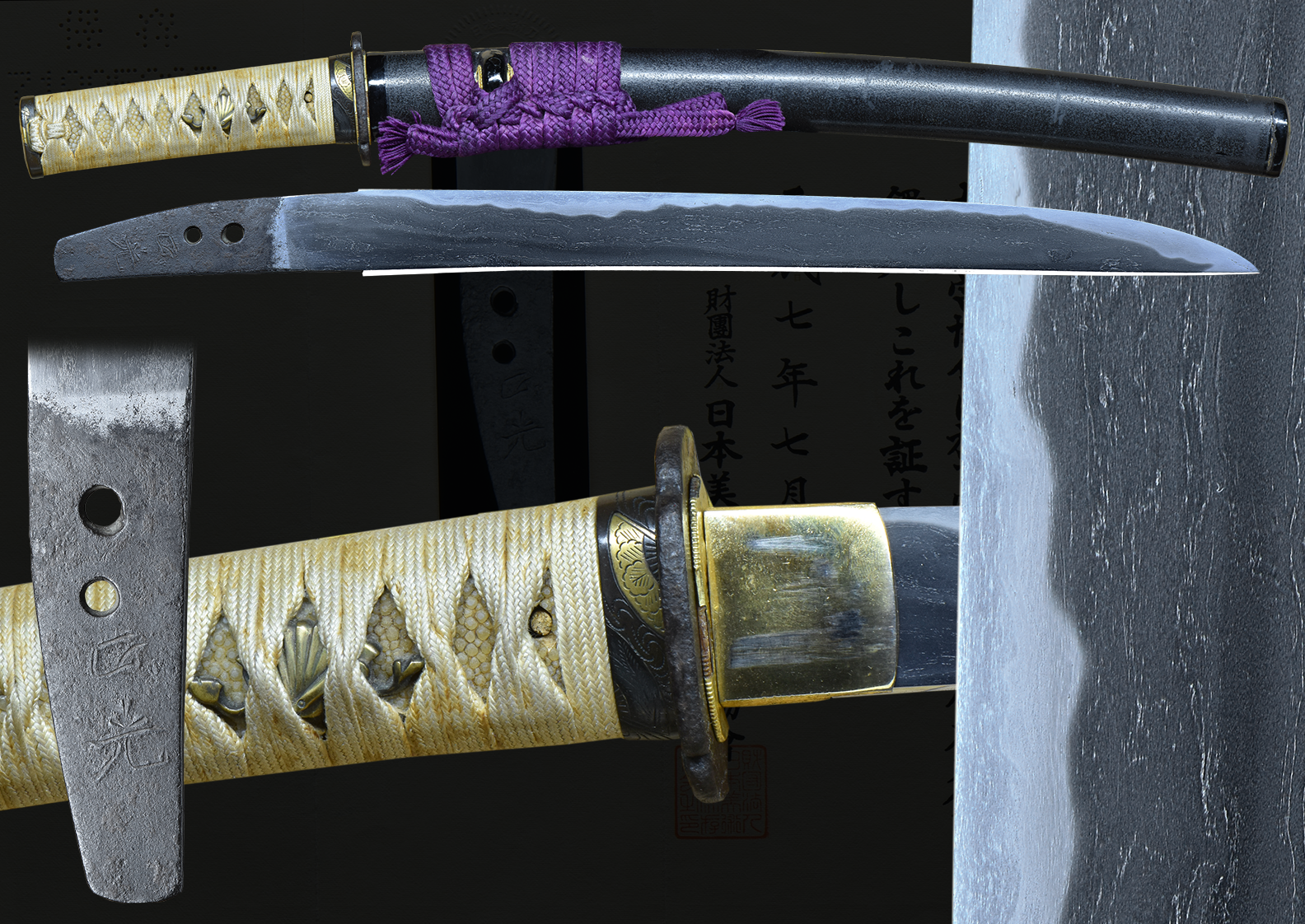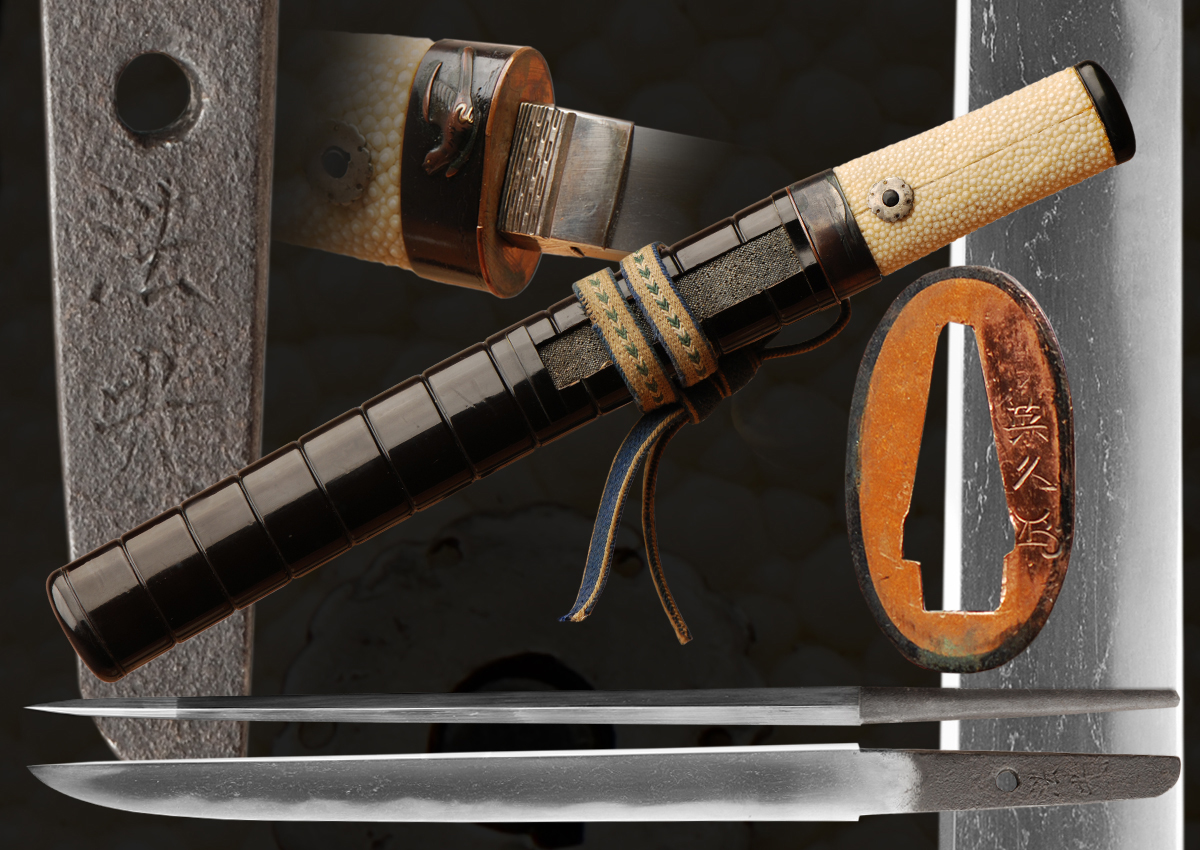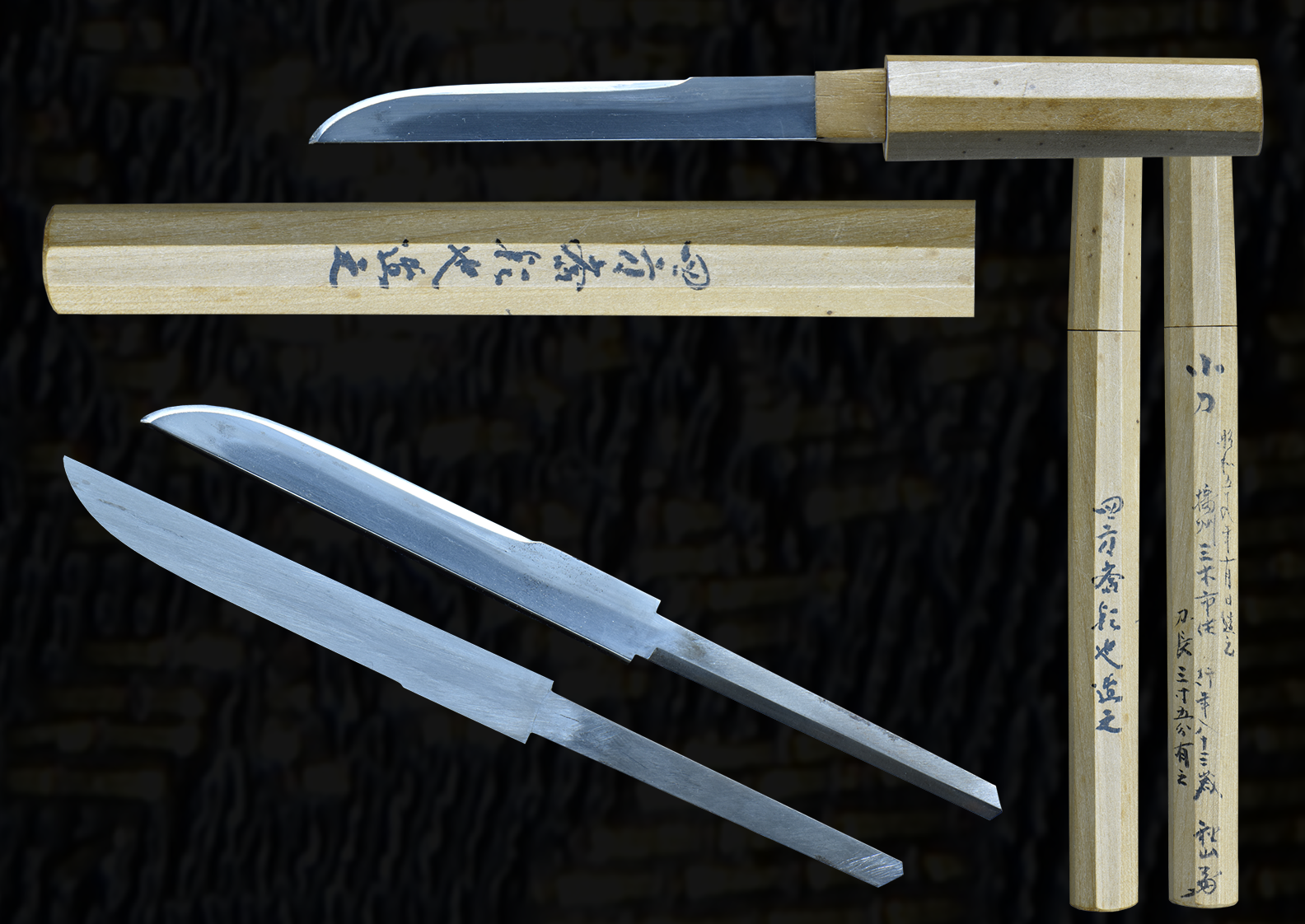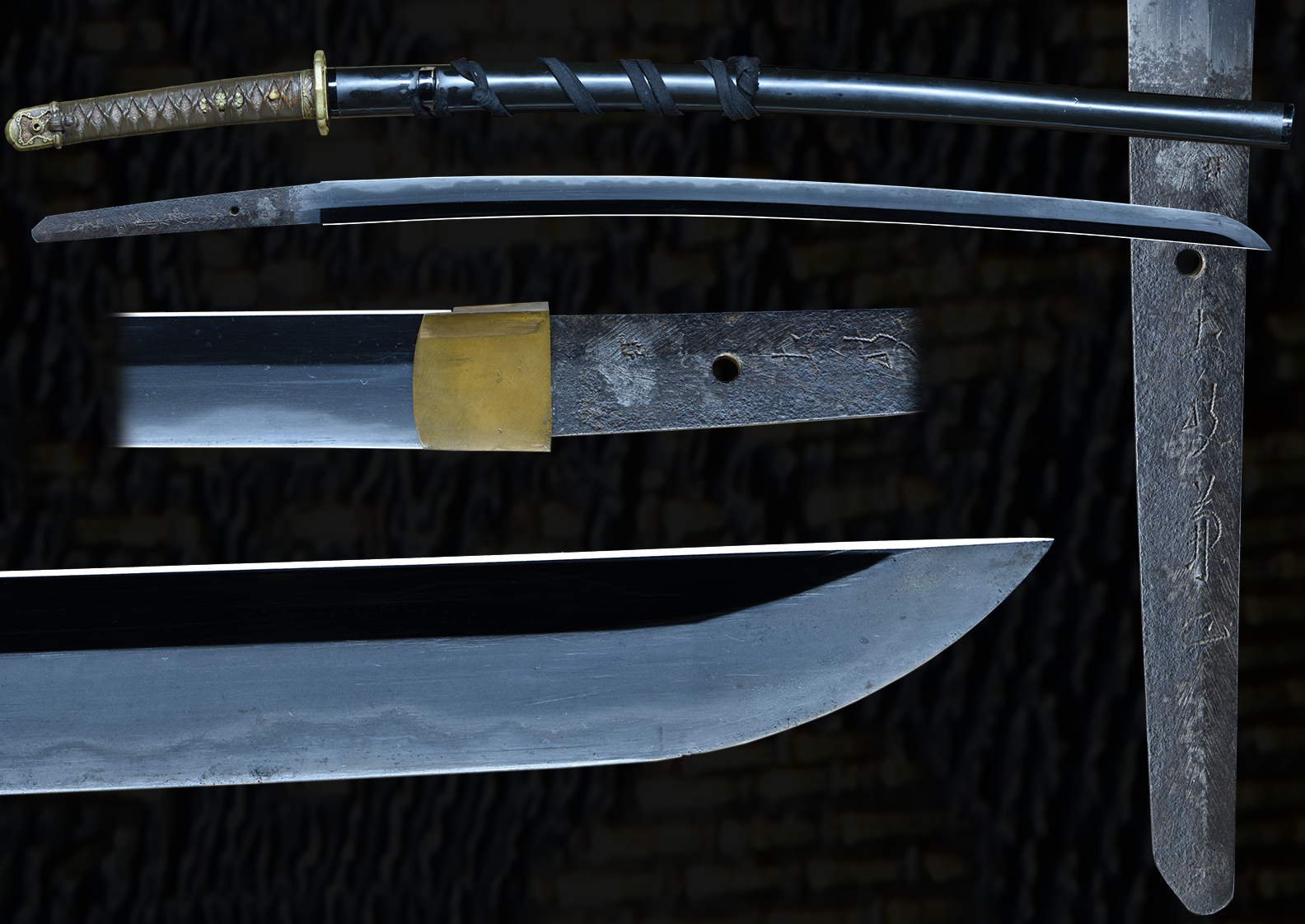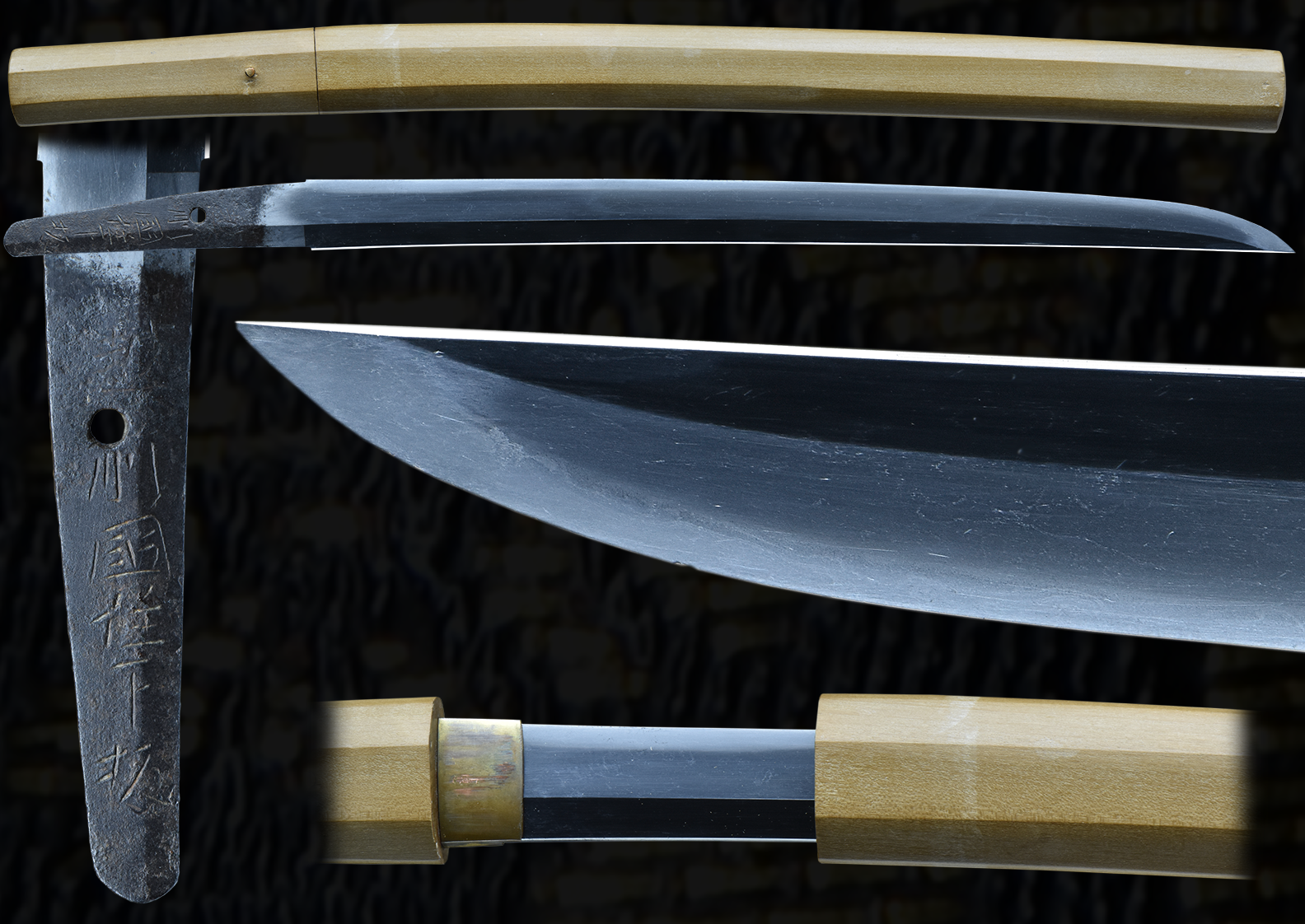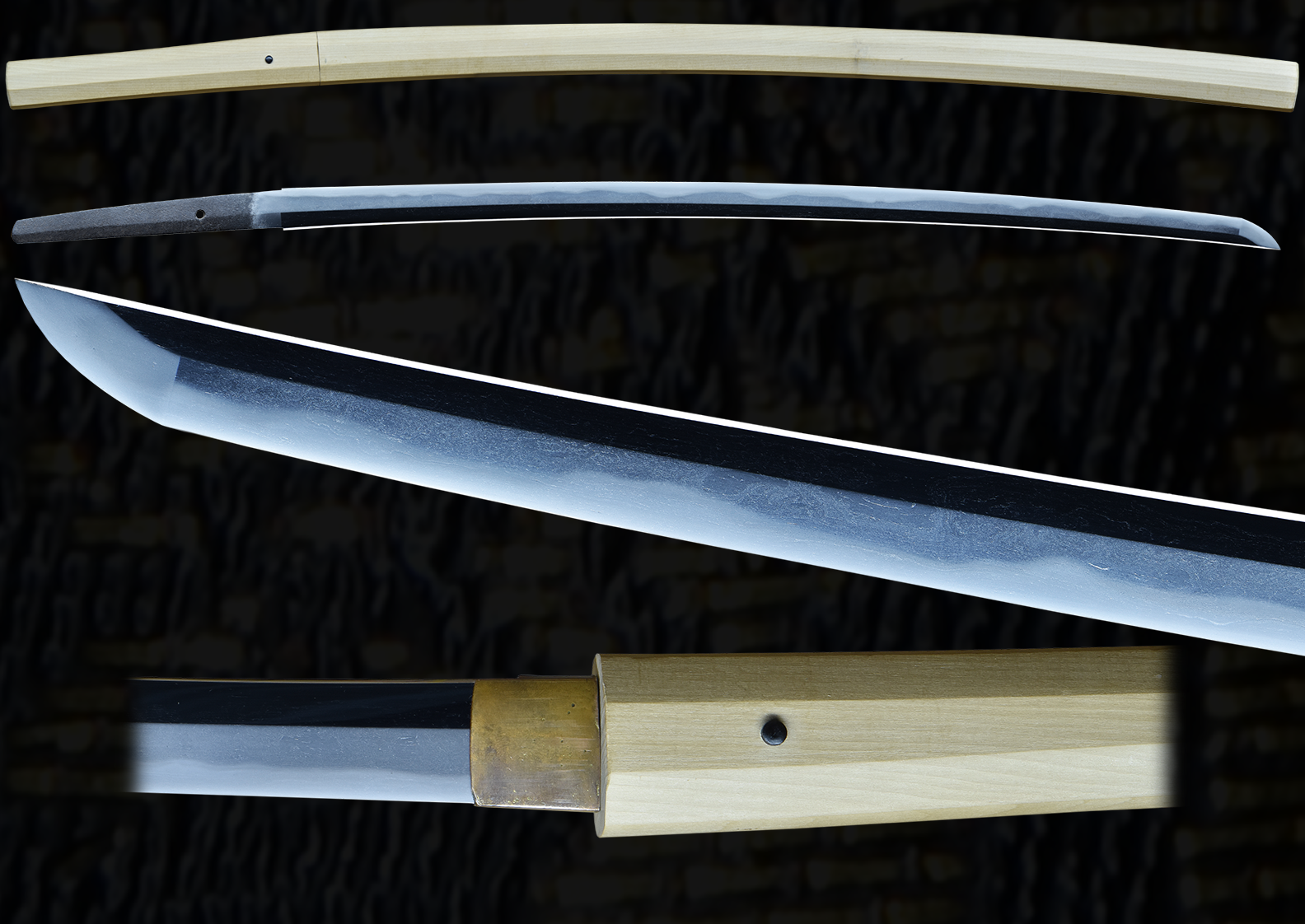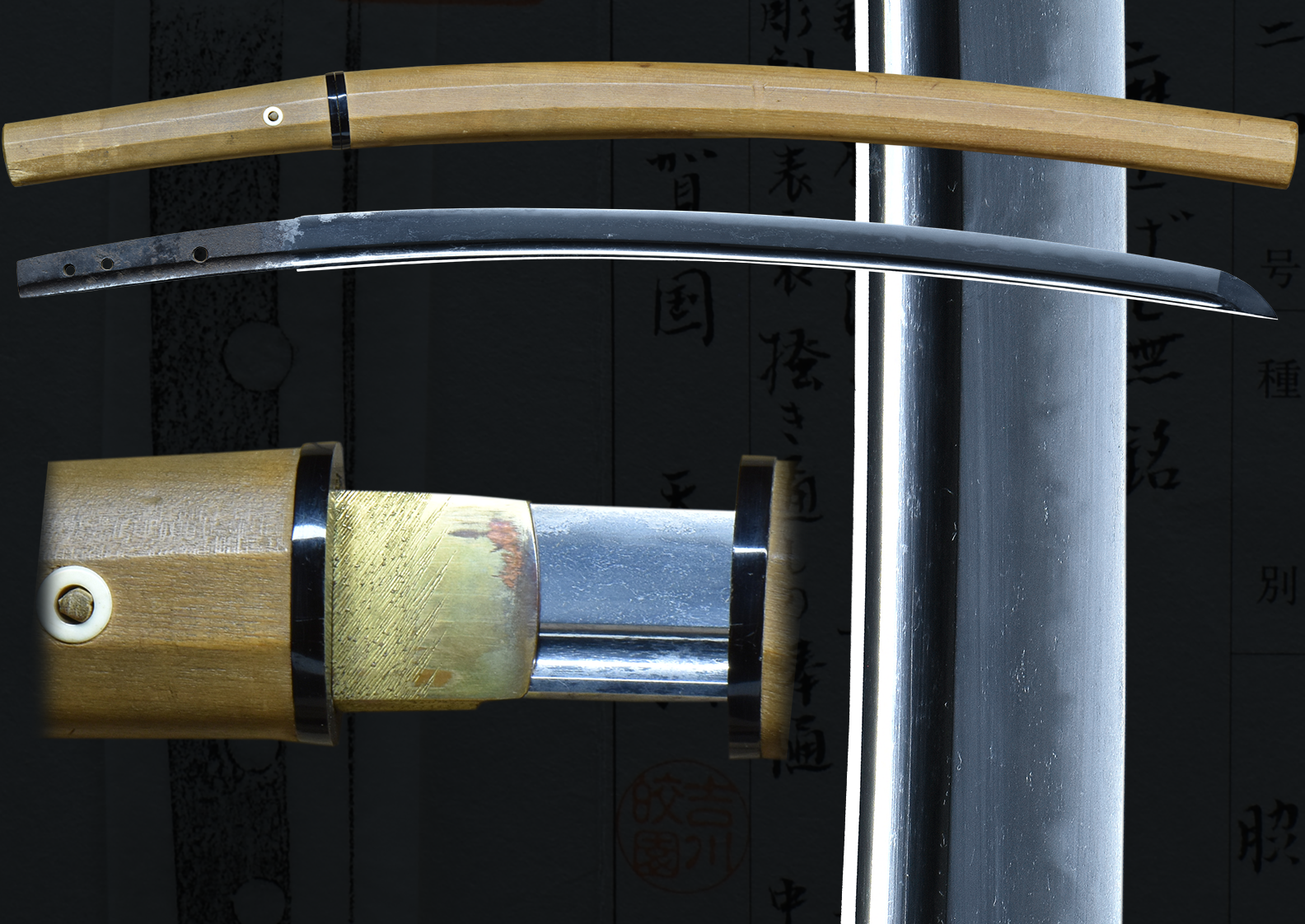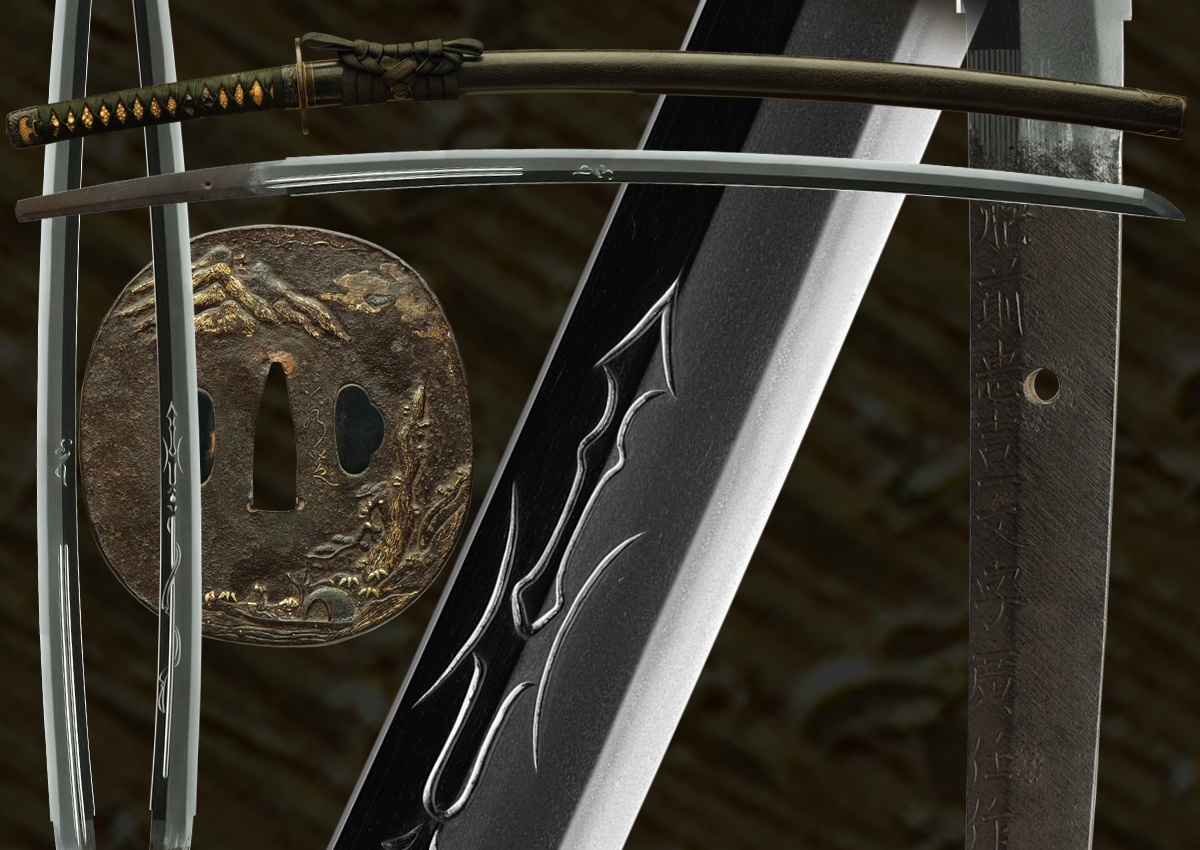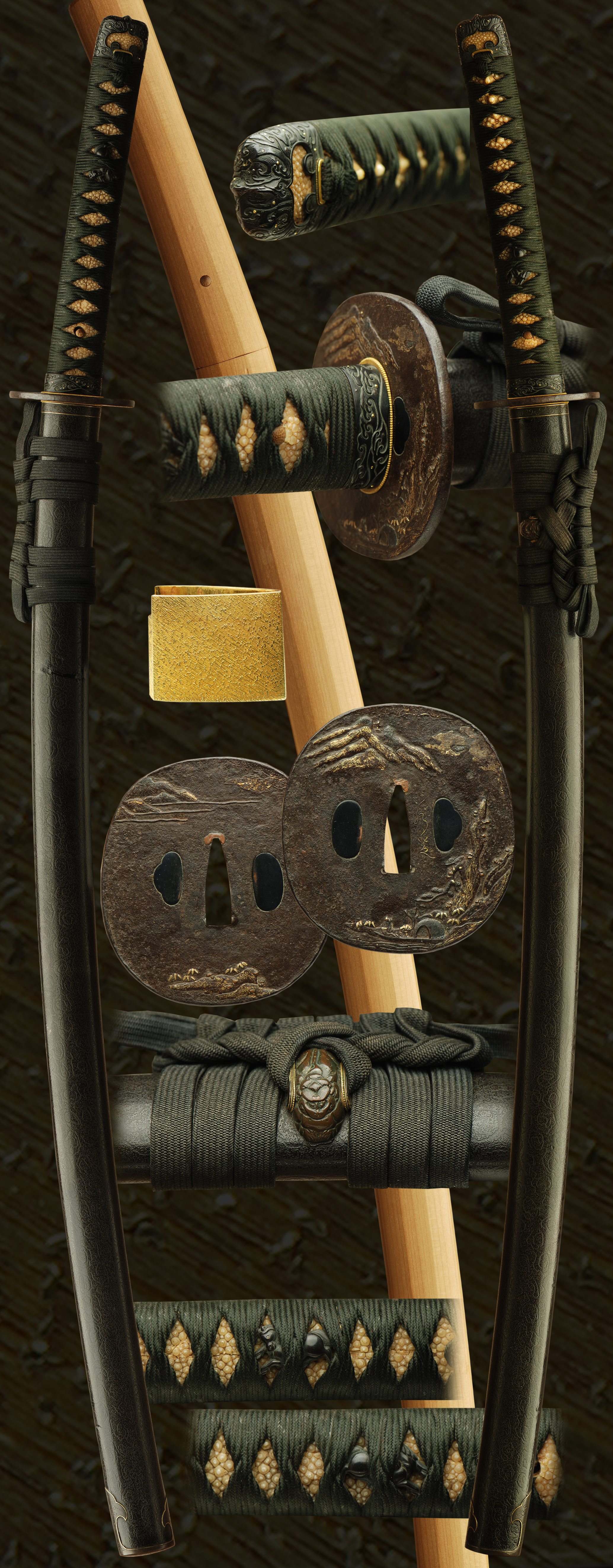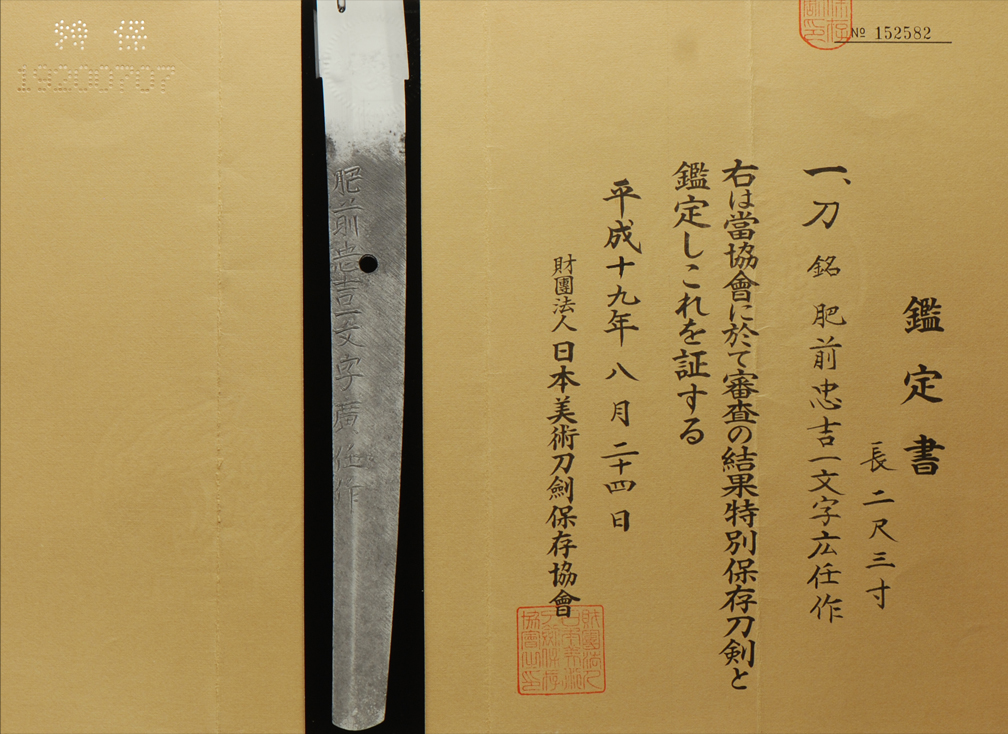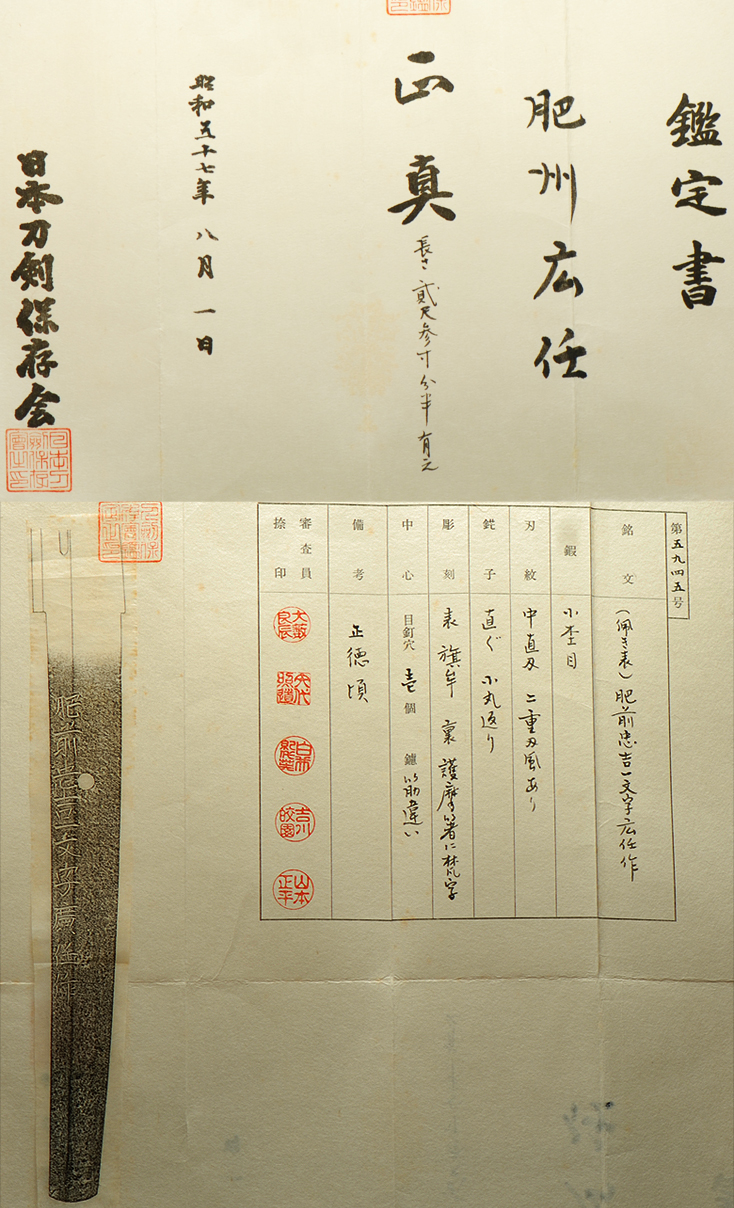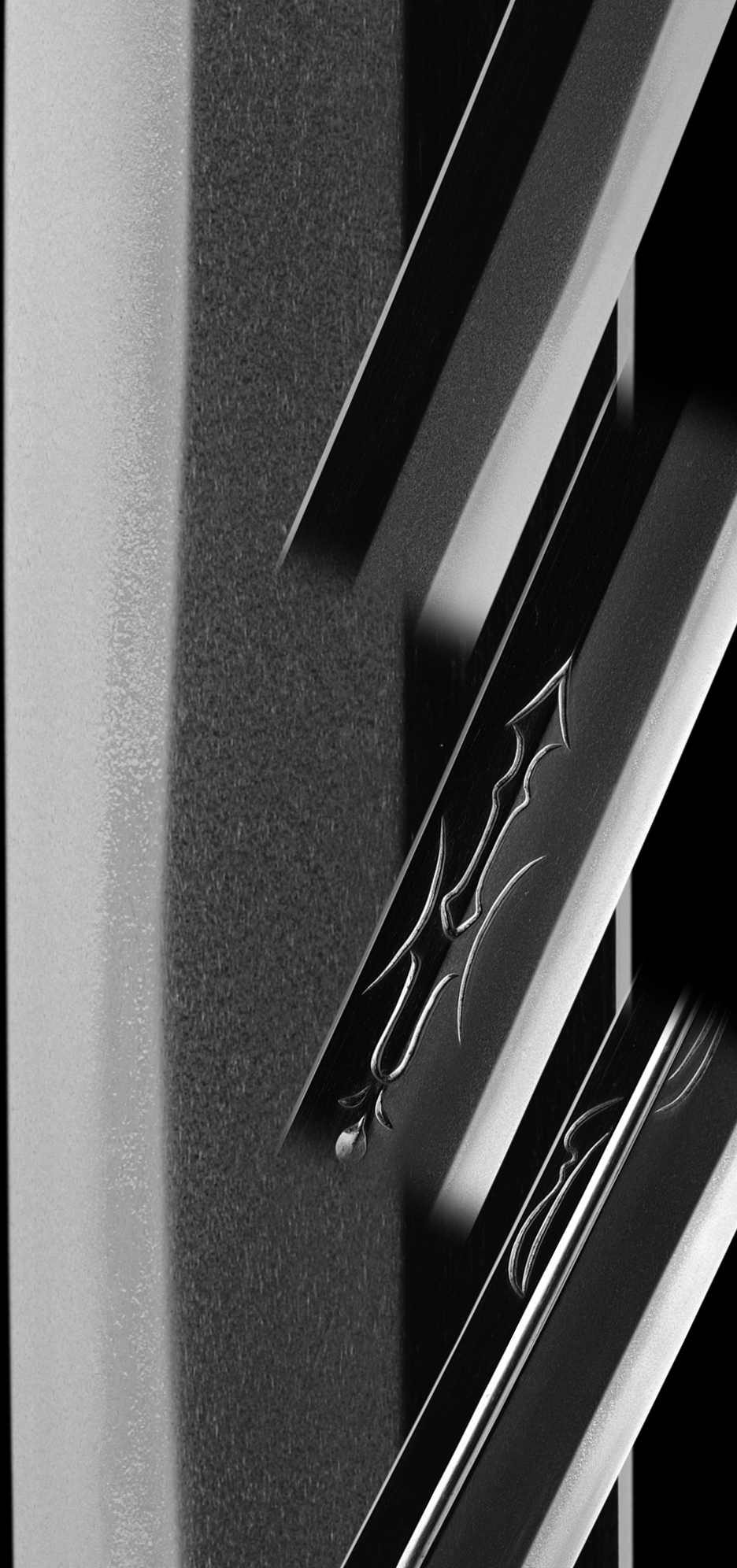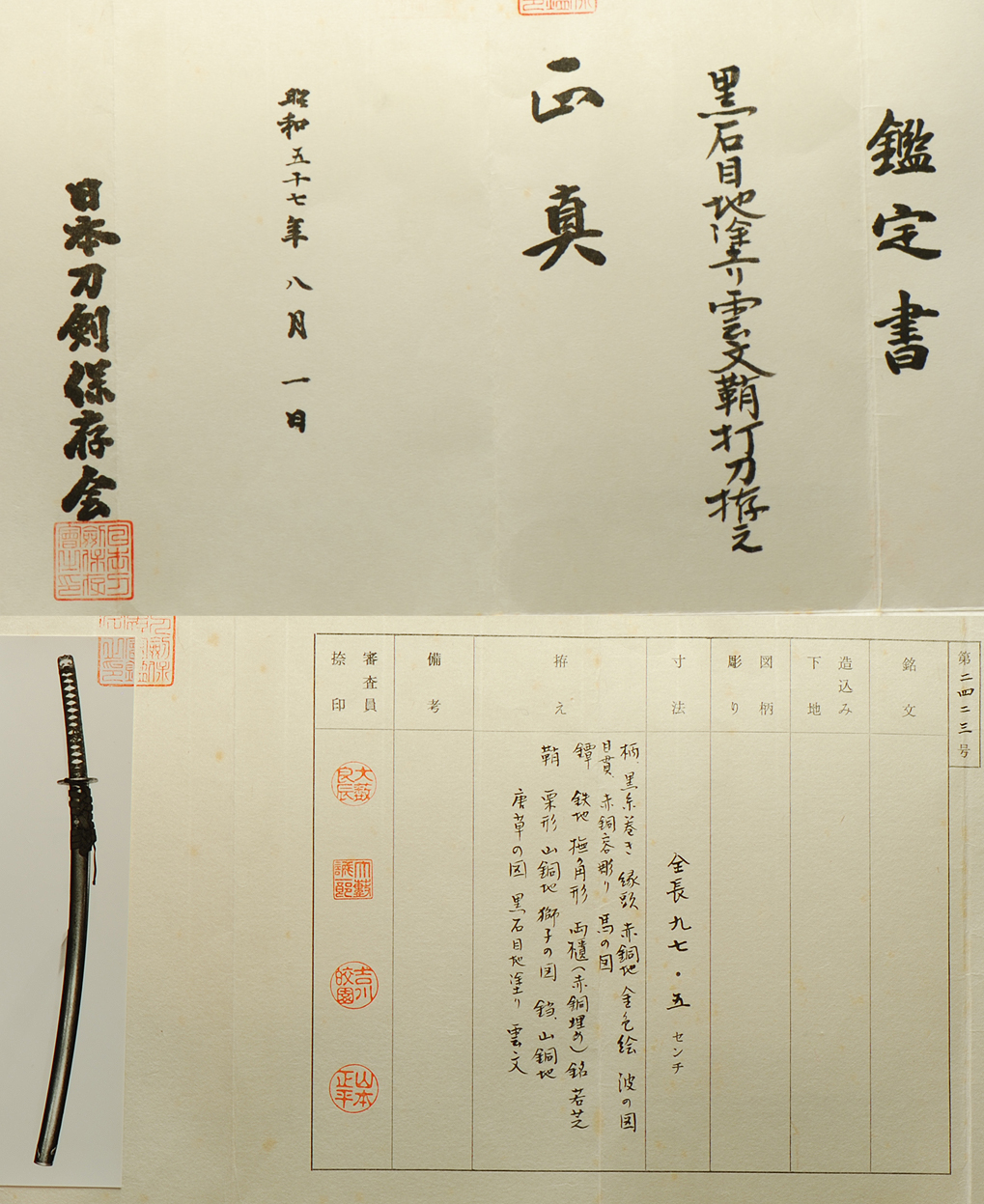This sword wa made by: HIROTŌ (広任), 1st gen., Kyōhō (享保, 1716-1736), Hizen – “Hizen Saga-jū Fujiwara Hirotō” (肥前佐賀住藤原広任), “Tadayoshi-son Ichimonji Hirotō” (忠吉孫一文字広任, “Ichimonji Hirotō, descendant of Tadayoshi”), “Bitchū no Jō Hirozumi” (備中掾広住), “Etchū no Jō Yoshizumi” (越中掾吉住), “Hizen-jū Etchū no Jō Hirozumi” (肥前住越中掾吉住), real name Hashimoto Yashichibei (橋本弥七兵衛), second son of the 1st gen. Yukihiro (行広), he died in the eleventh year of Kyōhō (1726), in later years he used the name Hirozumi (広住) and changed that name once more to Yoshizumi (吉住) but he used different honorary titles with each of these names, suguha, gunome-midare or notare in ko-nie-deki. The sword is polished with horimono of a polearm with banner on one side and gomabashi and a bonji on the other mounted in Shirasaya with a gold washed habaki finished in a rain pattern design. The sword also has a splendid koshirae. The saya is finished black in the togidashi makie style with a cloud design. The koiguchi and Kojiri are of shakudo in an arabesque pattern trimmed in gold. The tsuki ito is a dark teal finish with deep rich shakudo horses for menuki. The kurikata is of a Shishi. The fuchi / kashira is of a wave design in a deep rich shakudo with gold dots. The sageo is black. The tsuba is of iron with a Jakushi style landscape of mountains finished with gold. An incredible sword with great lineage and comes with two sets of papers. NTHK kantei-sho on the sword and another set of kanteisho-for the mounts/koshirai. Koshirai papers are generally not common. Finally the sword also high level Hozon Tokubetsu papers from the NBTHK also.
About this smith and the schools history:
In the Tokugawa period, Saga was the capital of Hizen province and ruled over by the powerful Tozama Daimyo family, the Nabeshima. It is their heraldic crest or Mon, which is the crest appearing on Kenseikai Tenugui and Do. The Nabeshima clan were very powerful and rich, their wealth being based on several thriving industries, including the famous Nabeshima pottery which is much sought after today. However, arguably of more interest, was their highly successful manufacture and export of swords.
These swords are of excellent quality in both artistic and practical terms. They are also well documented in Japanese books and because of their prolific production, there have been a reasonable number obtainable in the West without the necessity of re-mortgaging one’s domicile.
At the beginning of the Tokugawa period (the Keicho period, 1596-1624), the Nabeshima Daimyo retained a swordsmith named Hashimoto Shinsaemon who adopted the professional name of Tadayoshi. The young Tadayoshi, who was from samurai lineage, had been orphaned as a child and brought up by his grandfather who himself was killed in battle. Before setting up his forge in Saga for the Lord Nabeshima, Tadayoshi had previously studied under a great teacher in Kyoto named Umetada Mioju, who was a genius metal worker making superb Tsuba as well as making blades with highly artistic carvings (Horimono) on them.
This was a time of renaissance in the history of the Japanese sword. It was the end of the Sengoku Jidai (period of the country at war) and the beginning of the Keicho period (1594) is recognised as the start of the so-called Shinto (New Sword) period of Japanese sword manufacture. It was not now necessary for swordsmiths to tum out large numbers of simply practical swords, as was required during the Sengoku Jidai, and now they could take more time to produce better quality blades emphasising the more artistic properties of the Japanese sword. Tadayoshi produced many fine swords many of which were carved with elaborate Horimono executed by a fellow student of Umetada Mioju, named Munenaga.
Tadayoshi attracted many students and swords made by the Tadayoshi school were exported by the Nabeshima clan all over Japan. The definitive Hizen-to may be described as having a strong Sugata (form or shape) with a skilfully controlled Suguha Hamon (straight quench-line) which is comprised of fine Nie (crystalised martensite) and which ends in a Ko-maru Boshi (small circular quenching pattern in the point). Further, Nie are sprinkled all over the Jihada (surface) producing a unique surface pattern known as Konuka-hada. Such swords had a reputation for being Saijo Wazamono (supremely sharp) as well as being things of great beauty and as such brought much credit both to Tadayoshi and the Nabeshima Daimyo.
In addtion to the main Tadayoshi line, of which there were nine continuous generations, collateral family lines such as Masahiro, Yukihiro and Tadakuni were prolific, all working in and around Saga for both the Nabeshima clan and their relatives. By the middle of the 17th century, the reputation of swords from Hizen province was well respected throughout Japan and their export contributed greatly to the prosperity of the Nabeshima Han. Unfortunately this fame led to many forgeries, the majority of which are in the Tadayoshi Goji Mei (Tadayoshi’s 5 character signature) of HIZEN (no) KUNI TADAYOSHI.
Tadayoshi signed his work in many different ways throughout his career, but the above Goji Mei is probably the most commonly used. This form of signature was also used by the succeeding generations (except for the 2nd generation who never adopted the Tadayoshi name and was called Tadahiro). When Tadayoshi retired as the head of the family he was granted the title MUSASHI DAIJO and he changed his name to Tadahiro.
Several of the collateral lines, whilst often producing blades with Suguha Hamon (which incidentally is considered more effective when cutting) were also skilled at other styles, particularly Bizen-den. Indeed the Choji (clove shaped) Hamon that is characteristic of Bizen swords was adapted and slightly altered by Hizen swordsmiths. This difference is readily discernible to the practised eye. The line of smiths named Yukihiro acknowledged this Bizen influence by including the character ICHI in the inscriptions on their Nakago. This stood for ICHIMONJI (number one) which the Yukihiro’s sometimes also spelt out in their inscriptions.
Nagasaki is within Hizen province and this was the centre of foreign influence throughout the Tokugawa period when the rest of the country was closed to foreigners. Through Nagasaki it appears that some import of foreign iron took place and was used by some of the swordsmiths. This may be seen by inscriptions on Nakago such as Orande Tetsu Saku (made with Dutch iron). It is also known that the 8th generation Tadayoshi (who died in 1853 and who is rated as the 3rd most skilful Tadayoshi) experimented with foreign iron in sword manufacture and cannon production for coastal defences.
Although Hizen-to were produced for over 260 years (from 1594 to 1870-ish) unlike many sword production centres over this period Hizen-to, comparatively speaking, maintained a very high standard and tended not to be affected by the passing fashions of the time but rather maintained their integrity. Of course, there were certain generations and individuals who were not as good as others, it would be impossible for all to be great artists, but generally speaking a samurai could feel confident with a Hizen-to in his Obi.
- Mei: Hizen Tadayoshi Ichimonji Hirotō saku
- Date: around Shōtoku (正徳, 1711-1716)
- Nagasa: 27-1/2 inches
- Sori: 18.0 mm
- Width at the ha-machi: 31.5 mm
- Width at the yokote: 21.6 mm
- Thickness at the mune-machi: 6.9 mm
- Construction: Shinogi zukuri
- Mune: Iori
- Nakago: Ubu
- Kitae: ko-mokume
- Hamon: chū-suguha that tends to nijūba in places
- Boshi: Maru
- Condition: Good polish
Click to Enlarge Image
TOKUBETSU HOZON KAI PAPERS
NBTHK
Kantei-Sho (鑑定書) – Appraisal
No 15258
katana, signed: Hizen Tadayoshi Ichimonji Hirotō saku (肥前忠吉一文字広任広)
nagasa ~ 69.7 cm
According to the result of the shinsa committee of our society, we judge this work as authentic and rank it as tokubetsu-hozon-tōken.
August 24, 2007
[Foundation] Nihon Bijutsu Tōken Hozon Kyōkai, NBTHK (日本美術刀劍保存協會)
Kantei-sho (鑑定書) – Appraisal
Hishū Hirotō (肥州広任)
shōshin (正真) – Authentic
nagasa 2 shaku 3 sun bu han kore ari (長さ貮尺参寸分半有之) – Blade length 69.7 cm
Shōwa 57 nen 8 gatsu 1 nichi (昭和五十七年八月一日) – August 1, 1982
Nihon Tōken Hozon Kai (日本刀剣保存会) – NTHK
No 5945
meibun (銘文) – Signature: (haki-omote) Hizen Tadayoshi Ichimonji Hirotō saku
(肥前忠吉一文字広任作)
kitae (鍛) – Forging: ko-mokume
hamon (刃紋) – Hardening: chū-suguha that tends to nijūba in places
bōshi (鋩子) – Hardening in tip: sugu with a ko-maru-kaeri
chōkoku (彫刻) – Engravings: on the omote side a hatahoko, on the ura side gomabashi and bonji
nakago (中心) – Tang: mekugi-ana (目釘穴) 1, yasurime (鑢): sujikai
bikō (備考) – Remarks: around Shōtoku (正徳, 1711-1716)
shinsa’in natsu’in (審査員捺印) – Seals of Judges: 5 seals
(shipping and insurance included)
Email us if your interested in this item and remember to include the order number for this item: fss-791.
Click to Enlarge Image
Click to Enlarge Image
Kantei-sho (鑑定書) – Appraisal
Kuro-ishimeji-nuri un’mon-saya uchigatana-koshirae (黒石目地塗雲文散鞘打刀拵) – Uchigatana-koshirae with a black ishimeji-lacquer saya with cloud ornamentation
shōshin (正真) – Authentic
Shōwa 57 nen 8 gatsu 1 nichi (昭和五十七年八月一日) – August 1, 1982
Nihon Tōken Hozon Kai (日本刀剣保存会) – NTHK
No 2423
meibun (銘文) ‒ Signature:
tsukurikomi (造込み) ‒ Shape: shitaji (下地) ‒ Foundation:
zugara (図柄) ‒ Motif: hori (彫り) ‒ Engravings:
sunpō (寸法) ‒ Measurements:
koshirae (拵え) ‒ Mounting:
overall length 97.5 cm
black hilt wrapping; fuchigashira of shakudō and with gold iroe, motif of waves; menuki of shakudō, in katachibori, depiting horses; tsuba of iron, in nadekaku-gata, two hitsu- ana (plugged with shakudō), mei: “Jakushi” (若芝)
saya with kurigata of yamagane and with shishi lion motif, kojiri of yamagane and with a karakusa design, black ishimeji-lacquer with cloud ornamentation
shinsaʼin natsuʼin (審査員捺印) ‒ Seals of Judges: 4 seals
For Sale
